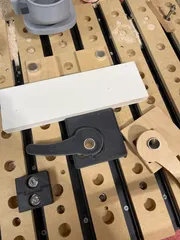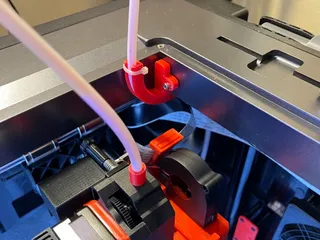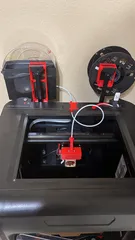X-Max (X-Plus) Z-Axis Micro Adjustable Limit Switch Mount
Z-Axis Limit Switch Mount allows for minor height adjustment and allows for inverting the steel bed support.
10
71
0
978
updated November 26, 2022
Description
PDFThese Z-Axis limit switch mounts allow for minor height adjustment and allow for inverting the steel bed support.
- The height adjustment is facilitated with an M3 screw that lifts the upright away from the base.
- Another M3 screw and nut secures the upright to the base.
- A clamp holds the limit switch tightly to the PCB with two M3 screws and nuts to minimize slop and increase reliable repeatability (see below).
- The mount moves the limit switch closer to the linear rod mounting base which allows for inverting the steel bed support so that the lip faces down and so is less likely to catch and trap debris, small parts, screws. etc. Note that an inverted steel bed support requires the bed adjustment nuts to be able to clear the lip. Suitable bed leveling nuts can be found here: https://www.printables.com/model/156426-bed-leveling-star-grip-nuts
Justification for Clamps
- On Qidi printers, the Z-Axis limit switches are held in place on the PCB with the electrical connection tabs which are flexible. This is not ideal because flexibility equates to variance which in this case can result in first layer failures.
- I was finding that if I ran the simple leveling routine multiple times in a row that I could tell the nozzle gap as measured using the Qidi paper was changing each time. Using Huma Beam's Dial Indicator Carriage (https://www.printables.com/model/59210-qidi-x-max-dial-indicator-carriage-and-bed-levelin) I verified that the bed level was indeed different each time.
- There are a at least three contributors to the variance: the anti-backlash nuts on the Z-Axis screws, the springs on the limit switches and the method by which the actual limit switches are fastened to the limit switch printed circuit board (PCB). This last one is the easiest to fix and likely the largest contributor.
- These simple brackets eliminate the variance caused by the mounting method by holding the limit switches securely which reduces the nozzle gap variance from 0.015 to near zero.
Printing and Assembly
Print with any stiff filament. If printing high temp filaments in a hot chamber, then PETG, PC, etc. is preferred. All parts are printed as orientated without supports. Installation is just a matter of fitting M3 screws and nuts.
Tags
Model origin
The author hasn't provided the model origin yet.




